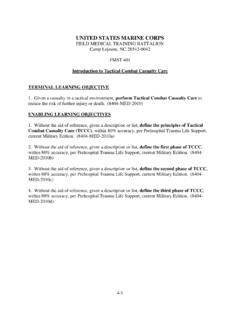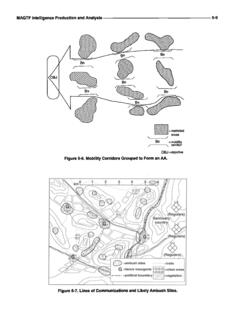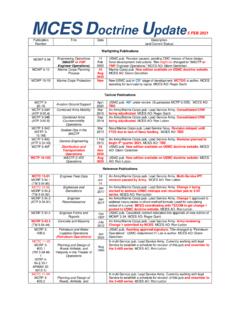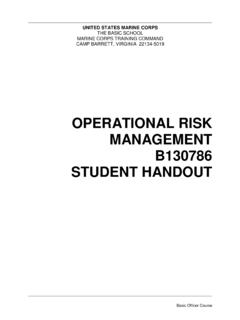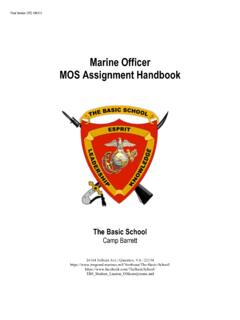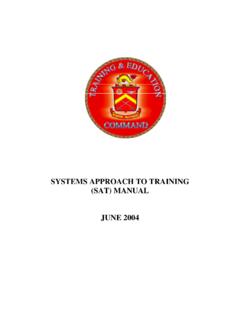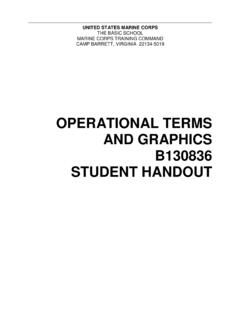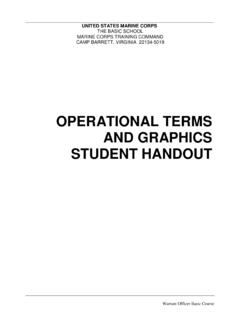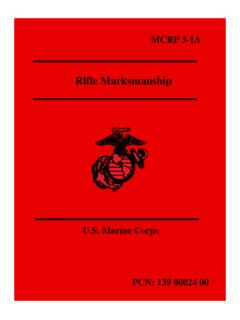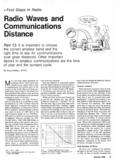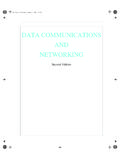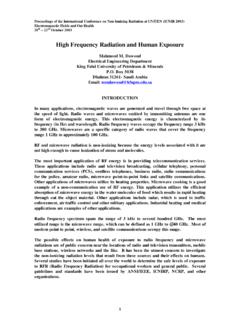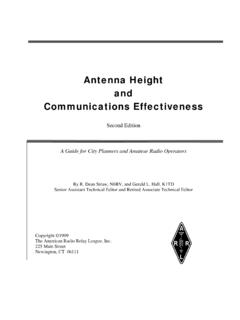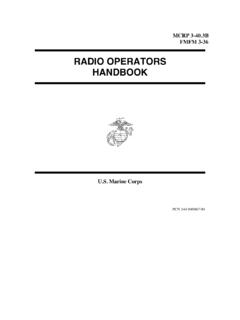Transcription of COMMUNICATION EQUIPMENT B191716 STUDENT HANDOUT
1 UNITED STATES MARINE CORPS THE BASIC SCHOOL MARINE CORPS TRAINING COMMAND CAMP BARRETT, VIRGINIA 22134-5019 COMMUNICATION EQUIPMENT B191716 STUDENT HANDOUT Basic Officer Course B191716 COMMUNICATION EQUIPMENT 2 Basic Officer Course COMMUNICATION EQUIPMENT Introduction In the Marine Corps, the primary purpose of communications is to serve the command. In this role, communications is the instrument by which commanders make their will known and, as such, is the voice of command. Importance The ability of commanders to pass information among their forces is critical to the outcome of an engagement on today's battlefield. In This Lesson This lesson covers the following topics: Topic Page Tactical Communications 4 radio Communications 8 radio Communications EQUIPMENT 11 Communications Security 14 Electronic Warfare 16 Telephone EQUIPMENT 19 Summary 19 Annex A: Types of EQUIPMENT 20 Annex B: AN/PRC 119 (RT-1523) Operations 33 Annex C: AN/PRC-119E/F (RT-1523E/F) Operations 33 Annex D: AN/PSN-13 (DAGR ) Operations 40 Annex E: AN/PRC-148 Operations 41 Annex F: AN/PRC-117F (RT-1796) Operations 43 Annex G: AN/PRC-150 (RT-1694) Operations 47 Annex H: AN/PRC-152 (RT-1619) Operations 50 Annex I: AN/PRC-153 Operations 54 Annex J.
2 Julian Date Calendar 55 References 56 Glossary of Terms and Acronyms 57 Notes 58 Learning Objectives Terminal Learning Objectives TBS-COMM-2101 Given a radio , perform basic radio operations to ensure EQUIPMENT is functional without compromising communications. TBS-COMM-1003 Given SL-3 complete field telephones and a spool of communications wire, communicate using wired communications to establish communications between sites. B191716 COMMUNICATION EQUIPMENT 3 Basic Officer Course COMMUNICATION EQUIPMENT (Continued) Learning Objectives (Continued) Enabling Learning Objectives TBS-COMM-1003a Given wired COMMUNICATION assets and SL-3 components, inspect EQUIPMENT to ensure serviceability. TBS-COMM-1003b Given wired COMMUNICATION assets, employ field phones, to establish communications between two stations.
3 TBS-COMM-1003c Given an established wired communications system, perform a communications check to conduct an operational check of the system. TBS-COMM-1003d Given a non-functioning wired communications system, trouble shoot wired COMMUNICATION devices to establish two-way communications. TBS-COMM-2101a Given a radio transmitter, SL-3 components, assemble a radio without omission. TBS-COMM-2101b Given a radio transmitter, SL-3 components and a CEOI, program a radio to communicate a message. TBS-COMM-2101c Given a radio transmitter, SL-3 components and a CEOI, conduct a communications check to establish radio communications. TBS-COMM-2101d Given a radio transmitter, SL-3 components and a CEOI, communicate a message to ensure the message is properly received/understood. TBS-COMM-2101e Given a radio transmitter, SL-3 components, troubleshoot a radio to re-establish communications.
4 TBS-COMM-2101f Given a radio transmitter, SL-3 components, maintenance requirements, preventive maintenance (PM) EQUIPMENT , maintain a radio set to support sustained operation. B191716 COMMUNICATION EQUIPMENT 4 Basic Officer Course Tactical Communications Communications COMMUNICATION is a means or method of conveying information from one person or place to another. Responsibility The responsibility for communications lies with the unit commander. The commander is responsible for the effectiveness of the communications systems as well as the tactical and technical aspects of communications. Tactical Responsibilities The course of action the commander selects must be supportable by the communications and information systems means available. The commander must locate the command post where it can best communicate with subordinate units and higher headquarters.
5 Technical Responsibilities The commander ensures that an active communications training program is in effect for all personnel in the command. Fundamental Requirements All communications systems must satisfy four basic requirements to be effective: Reliability is the assurance that communications will function with desired accuracy and dependability at all times. Thoroughly trained personnel achieve reliability through carefully planned employment of proven communications techniques and EQUIPMENT . Security is the protection resulting from all measures taken to deny unauthorized persons information of value. This includes preventing the possession and analysis of valuable information or misleading unauthorized persons in their interpretations of such an analysis. Speed denotes timeliness in the flow of information between users of communications and is based upon operational urgency.
6 Always remember MCDP-1's tenet that there must be a trade-off between speed and security. This applies to information flow as well as to maneuver. Flexibility is achieved by designing a communications system that can be adapted to changes in the commander's scheme of maneuver. This is an acknowledgment of the fluid combat environment we expect to encounter. B191716 COMMUNICATION EQUIPMENT 5 Basic Officer Course Tactical Communications (Continued) COMMUNICATION Means The methods used to convey information from one person or place to another are called communications means. Communications means that are employed within the operating forces include radio . Wire. Sound. Visual. Physical communications o Includes messenger (foot or motorized). o Augmented by mail (guard mail or US mail). Data communications, which include all computer and data transmission device.
7 Security of Communications The following table identifies the type of COMMUNICATION , its level of security, and the pros and cons for using each type. Type of COMMUNICATION Order of Security Pros Cons Messenger Most Secure In a tactical scenario, it is the only applicable physical means of communications. Most secure; nothing is more reliable or secure than a Marine charged with delivering a message. Reliable. Economical. Available to all units. Subject to Enemy actions. Physical limitations on modes of transportation caused by o Weather. o Terrain. Wire Interconnects closely- located command posts and positions. More secure than radio since the signal is limited to the wire line. Reduced probability of interception. Desirable in defensive operations. Compared to radio , to install and maintain requires more o Time.
8 O Personnel. o EQUIPMENT . Not a workable means when unit is mobile. B191716 COMMUNICATION EQUIPMENT 6 Basic Officer Course Tactical Communications (Continued) Type of COMMUNICATION Order of Security Pros Cons Sound Available to all units. Numerous types o Sirens. o Bells. o Whistles. Does not need electricity. Produces no electromagnetic signature. Easily misunderstood; simplicity is key to employment. Highly susceptible to interception. Enemy may use same signal for deception. Visual Available to all units. Numerous types: o Lights. o Panels. o Hand-and-arm signals o Pyrotechnics. Does not need electricity. Produces no electromagnetic signature. Easily misunderstood; simplicity is key to employment. Highly susceptible to interception. Enemy may use same signal for deception.
9 radio Least Secure Fast, flexible, and responsive. Can operate while mobile. Spans great distances. Crucial to high-tempo operations. Least secure means. Highly susceptible to enemy electronic warfare. Subject to interference from o Atmospheric conditions. o Terrain. o Manmade sources. Data Variable Security Fast, flexible, and reliable. Secure. Facilitates passing of large amounts of information. Inter-service, Department of Defense (DoD), and civilian connectivity. Can be pushed down to rifle company level. Highly susceptible to environmental effects. Not available to every unit. Requires reliable and sustainable power sources. Requires high degree of MOS expertise to install, operate, and maintain. B191716 COMMUNICATION EQUIPMENT 7 Basic Officer Course radio Communications radio Wave Fundamentals radio COMMUNICATION uses energy in the form of electromagnetic waves that propagate through space at the speed of light.
10 Since the mechanics of wave motion are much the same for all types of waves , the nature of radio wave motion and propagation can be understood by comparing it with surface waves on water. Almost everyone has thrown a stone into a pond and watched waves from the splash spread out over the surface of the water in ever increasing concentric circles. If the pond is large enough, the waves can be seen to grow weaker as they move away from the point of origin until they disappear. radio waves behave in a similar manner, except they expand in three-dimensional space. radio waves travel along the surface of the earth (ground waves ) and up into the atmosphere (sky waves ). Frequency and Wavelength Wavelength is directly related to frequency. Frequency is measured in terms of the number of waves generated (cycles) per second.
